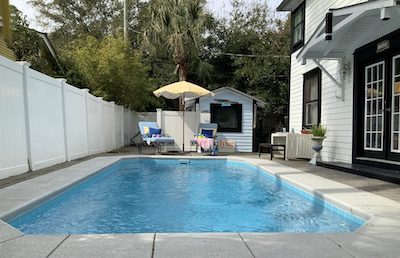HUNTER ARMY AIRFIELD — The installation’s 3rd Squadron, 17th Cavalry Regiment is preparing to say farewell to an old friend, the OH-58D Kiowa Warrior.
The Army is decommissioning the Kiowa after more than 40 years of service, mostly as a light reconnaissance helicopter. The Kiowa will be replaced by the UH-72 Lakota and UH-64 Apache. Next month, 3-17th CAV pilots will fly their 30 Kiowa Warriors one last time to Davis Monthan Air Force Base in Arizona.
Prior to losing the Kiowa, Lt. Col. Geoffrey A. Whittenberg, the unit commander, wanted to use the training preparation for the formation flight to Arizona as part of a final flight ceremony for the helicopter that had been so much a part of their lives.
On Wednesday, 22 of the Kiowa Warriors flew in formation from Hunter to Fort Stewart, then to Tybee Island and downtown Savannah before arriving back at Hunter, where each Kiowa flew through a water-cannon arch created by firetrucks from the Stewart-Hunter Fire Department.
“We just did a final flight of our aircraft,” said Whittenberg, who said he’s been a Kiowa pilot his entire career and has flown the helicopter in Bosnia, Iraq and Afghanistan. “We have a few down for maintenance. Typically, at the end of a pilot’s career and they’re on their last flight, they spray them with water. In this case, it’s not the pilots that are retiring; it’s the aircraft that’s being retired.
“It’s really a sad day for us. (The Kiowa) has provided a lot of support for a lot of ground forces. The Army has a strategy to continue to provide that kind of support for the soldiers on the ground. We just think the Kiowa can do it better than some.”
Whittenberg talked about the final flight, particularly about the missing-man formation the pilots performed as the Kiowas passed over Warriors Walk, where one of their own is remembered. He said many of the pilots worked and flew with Chief Warrant Officer 3 James E. Groves III, who was killed in action in Afghanistan in March 2013. He added that Groves’ wife was attending the final flight ceremony.
Seeing that many helicopters in the skies above Fort McAllister, Fort Pulaski and Tybee Island, then over River Street in Savannah, may have had local residents wondering if they were being invaded. Before passing through the wall of water near their hangers, the 22 Kiowas made what looked like a victory lap around Hunter.
One by one, they then flew into the water arch. As each helicopter emerged on the other side, it looked at first like a strange-shaped car coming out of a car wash.
One of the pilots who made the final flight was 1st Lt. Chris Dudley, platoon leader for Bravo Troop.
Dudley said it was an honor to take part in the final flight of 3-17th CAV’s Kiowa Warriors, just as it has been an honor to serve in the air cavalry, to wear the famous black Stetson hat and spurs and to be part of a unit with such a long, proud history.
Chief Warrant Officer 4 Jim Carrico, senior instructor and standardization officer, agreed with Dudley as he described their unit as a close-knit group with high esprit de corps. He said the history of the cavalry has always been to “get out in front.” He said cavalrymen might have changed from riding horses to helicopters, but their mission is pretty much the same.
Carrico also agreed with his commander, saying the day’s event was especially sad for him. He said, however, that he plans to stay in the Army to see what new technology would be provided to aviators so they can continue to support ground troops.
“The best part of the whole flight for me was being able to do it as a unit,” Whittenberg said. “(It was important) just being together one last time. It was (also) the first time we’ve had 22 aircraft in the air as one formation.”
Whittenberg said the unit will be inactivated Sept. 1, then reactivated Oct. 1. When the unit is reactivated, the pilots will fly the UH-64 Apache. The 3-17th CAV was first activated in 1916, he said.


